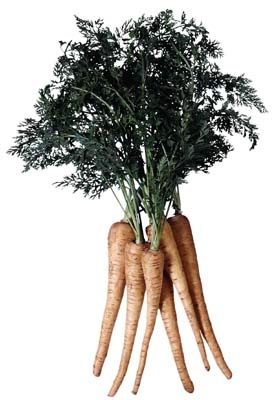

Parsnip

Pastinaca sativa. Umbelliferae. A biennial grown as an annual for its edible tapering root. It is a native of Siberia and Europe including Britain and has been cultivated at least since Roman times. It is widely grown in temperate regions, where it provides a valuable winter crop. The main harvesting period starts after roots have been first exposed to frost, which is considered to enhance their flavour. However, faster-maturing cultivars can be lifted during summer and storage of the later harvests provides continuity through until the following spring. Parsnips require an open site and grow best in a deep, well-cultivated soil free of stones. Fresh manure should not be added as it may cause roots to fang. On poor or heavy soils, improved quality roots may be grown from seed sown directly into planting holes, about 90cm deep, 15cm across, made with a crowbar; care must be taken to avoid compaction of the surrounding soil. Fill the planting hole with fine earth or a fertile loam based propagating mix. This technique is also used for exhibition specimens. Parsnip seed rapidly loses viability and only fresh seed should be used in establishing the crop. Germination is slow and erratic under cold conditions and it is preferable to delay sowing until soil conditions improve during late spring, or alternatively raise young plants in peat blocks under protection using gentle heat. In open ground seeds should be sown 2cm deep in groups of two or three seeds which can be singled following establishment. Plant spacing will depend on the choice of cultivar and the preferred size of root. For large roots (crown diameter in excess of 5cm), large-rooted cultivars spaced in rows 30cm apart with 15cm between plants within rows is recommended. For smaller cultivars this method should be reduced to 20cm between rows and 8cm within rows. Parsnips are relatively slow growing and are in the soil for a long period. The ground between widely spaced rows can therefore be usefully intercropped with faster-growing species such as radish or small lettuce. Parsnips develop a strong taproot and consequently watering is only required under dry conditions. However, if conditions become too dry, root splitting may take place following either rain or watering. Roots can be lifted when required from late summer onwards. They are hardy and will withstand exposure to frost, although harvesting during frosty conditions is easier if they are protected by a layer of straw or bracken. They may also be lifted and stored under cool conditions in boxes of sand. Pests and diseases include celery fly, carrot fly and canker. Recommended cultivars include ‘All America’: smooth, slender, pure white flesh; ‘Avonresister’ small, bulbous, canker-resistant; ‘Cobham Improved Marrow’: long wedge-shaped, canker-resistant; ‘Fullback Short Thick’: stumpy; ‘Gladiator F1’: uniform, medium to large, canker-resistant; ‘Harris Model’: uniform, tapered, very white; ‘Hollow Crown’: long, tapering; ‘Tender and True’: long, tapering; ‘White Gem’: wedge-shaped, canker-resistant.
|
Home
Grow Nuts
Grow Herbs
Grow Fruit
Cyberian Index
If you like this website and want one of your own contact
Cyberian All information correct at
time of publication and open to updates as necessary. No part of this website,
or its vectors, may be produced in any shape or form, using any type or design
of medium, system, equipment or otherwise without the prior written consensual
notice of the Cyberian. Any breach of these requirements will result in the
appropriate action. If in doubt, e-mail contact is recommended.
Some components of this website were obtained as open-source software and are
used in the same non-profit manner on this website.